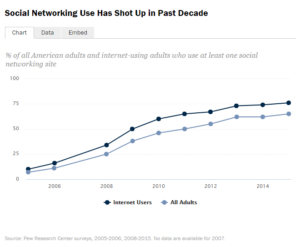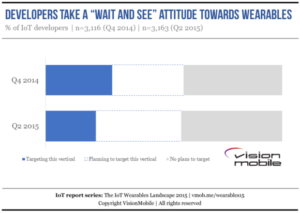A drop in the number of developers focusing on wearables, a surprising increase in both digital and print newspaper ad spending, a Pew study on social media use over the past decade, the percentage of ads in Facebook’s News Feed, and more are covered in this installment of TFP’s Media Metrics roundup.
To help you keep up with trends and prepare for changes just around the corner, each month we compile excerpts from some key reports covering issues affecting the publishing and media industries. Here are our top picks.
Why The Wearables Developer Market Population Is Taking A Plunge (ReadWrite)
- 21% of Internet of Things (IoT) developers have near-term plans to develop for wearables such as smartwatches, a decline from 28% six months earlier, according to a recent VisionMobile report. It said the trend indicates that in the short term, developers are taking a wait-and-see approach to the market.
- Although shipments of wearables spiked 223% between Q2 2014 and Q2 2015, the number of units shipped in Q2 this year totaled just 18 million, which is not enough to draw large numbers of developers, the report said.
- Despite those findings, VisionMobile is sticking to its original forecast that IoT, including the wearables market, will require 4.5 million developers by 2020, with most (44%) expected to be located in the Asia-Pacific region.
Shocker: Newspaper Advertising Is Up (Media Life Magazine)
- Standard Media Index reported print newspaper ad spending was up 18% in September, contributing to overall ad spending growth of 6%. Print newspaper ad spend jumped 16% for the quarter.
- Newspapers’ digital advertising also went up in Q3, by 10%.
- Consumer electronics and entertainment brands were the top advertisers, with each vertical doubling its spending in the quarter.
Social Media Usage: 2005-2015 (Pew Research Center)
- Pew reported that nearly two-thirds of adults in the U.S. (65%) use social media sites, up from just 7% in 2005, when it began tracking usage.
- Today, 90% of those 18 to 29 years old use social media, the largest group of users. But use among those 65 and older has jumped too, from 2% in 2005 to 35% a decade later.
- While for many years women were more likely to use social media than men, use by gender is now almost equal (68% vs. 62%, respectively).
- The latest study didn’t find big differences in usage among racial or ethinic groups: 65% of whites, 65% of Hispanics, and 56% of African-Americans now use social media.
- Nor did it find wide gaps based on community type, with 58% of rural residents, 68% of suburban residents, and 64% of urban residents using social media today.
Only 3% of Facebook’s News Feed Is Ads (Business Insider)
- A study by social media marketing firm Socialbakers found that just 3% of Facebook’s News Feed is made up of ads (not taking into account mobile or right-hand rail ads).
- Some 24% to 29% of the typical News Feed consists of content from Pages, with 10% of Page posts sponsored overall. The report noted, however, that 97% of the content users actually see in their feeds is organic as opposed to sponsored.
- Content from media and publishers’ Pages saw about three times more interactions versus brand Pages, a reversal from findings in a 2013 study.
New Pew Study Finds Small Dip in Book Reading Among Americans (Talking New Media)
- According to recent research from Pew, 72% of American adults have read a book in the past 12 months, a slight decline from 76% last year and 79% in 2011.
- It also showed a dip in e-book reading among adults: 27% compared with 28% last year.
- 80% of young adults (ages 18 to 29) reported they read a book in the past year, compared with 71% of those 30 to 49 years old, 68% of those 50 to 64, and 69% of those 65 and older, the report said.
Digital Natives Like BuzzFeed and Business Insider Rule Facebook Video Early On (The Wall Street Journal)
- Data from Tabular Labs shows that among publishers posting directly to Facebook, digital natives are seeing more early success than traditional media companies. The analytics firm said BuzzFeed, for example, held four of the top five spots in its September ranking of Facebook publishers, hitting a record 2 billion views for the month.
- In the same period, the broader BuzzFeed Video page took the top video spot on Facebook, while food-related BuzzFeed Food and Tasty came in second and third.
- Another digital publisher surging in September was new Business Insider sister publication Tech Insider, which came in ninth, marking the first time it has appeared on the new ranking.
Getting Pushy with Notifications Can Pay Off with Millennials (Street Fight)
- A survey of 500 U.S. millennials by Retale showed 84% of respondents act on push notifications they receive, especially if sent from a favorite brand (89%).
- It also found that 94% of respondents use location-based apps, highlighting the value of connecting content with customers’ context.
- The types of notifications millennials prefer are coupons and discounts (61%) and customer rewards (61%), followed by new product information and sale availability (35%), store locations and store hours (35%), and receipts after purchases (27%).
Digital Ad Fraud’s Price Tag: $18.5 Billion (Media Life Magazine)
- Distil Networks and the Interactive Advertising Bureau reported that ad fraud results in annual losses of $18.5 billion.
- Online ad spending is expected to reach $56 billion this year, meaning that about $1 out of every $3 spent on digital advertising is fraudulent, the report said.
- However, it found that 40% of marketers aren’t sure how bot traffic affects their campaigns or websites.
- Some 37% of ad buyers said they would be willing to pay at least 11% more for verified human traffic, and 10% indicated that they would pay 51% to 100% more for that guarantee.
Report: User Trust in Digital Security Is Declining (Social Times)
- According to data from Atomik Research, less than 5% of more than 2,000 millennials surveyed trust that their digital identity and data is “completely protected by effective safeguards.”
- 68% said they believe that the more digitally connected they are, the greater the risks to their privacy.
- Trust in the security of social sites is among the lowest of all verticals, with 61% of respondents reporting little or no confidence that their information is protected.
Media Metrics is a monthly feature from Technology for Publishing, aimed at keeping you armed with the latest industry data. If you’d like to share something you’ve read, drop us a note. And keep up with the latest industry news coverage by signing up for our This Week in Publishing emails or our monthly Publishing Innovations newsletter.
Posted by: Margot Knorr Mancini



